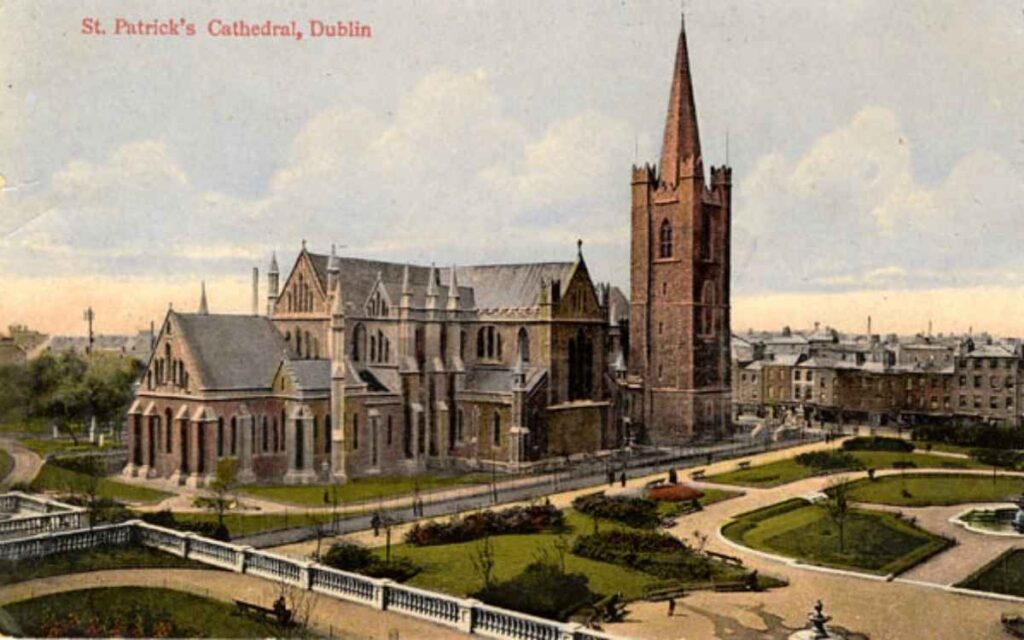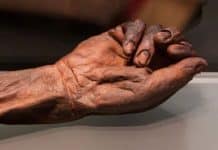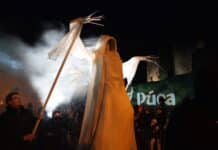When it comes to Ireland and places of worship, Dublin has some of the creepiest and spookiest churches you can visit! ANN MASSEY tells us how some of the parishioners include ghosts, a witch, mummies and even the Devil himself!

Dublin’s creepiest churches and cathedrals
St Patricks Cathedral, Dublin 8
The imposing Cathedral is built on what is believed to be the site of baptisms by Saint Patrick in the 5th century when he visited Dublin. There are hundreds of bodies buried within the Cathedral and grounds, including those of Narcissus Marsh and Jonathan Swift.
Jonathan Swift’s body was exhumed almost a century after his death and a post mortem took place to prove he had died from Meniere’s disease and not insanity as first thought. His body was returned to its burial place and the Cathedral is also home to a mask of his skull and death masks. It is of little wonder therefore that the prolific author and clergyman is still seen within the building he called home.
The most famous ghost of Saint Patrick’s is not human, but a Newfoundland dog. In 1861 a massive storm took place off of the coast of Dun Laoghaire, Dublin. A coal ship called The Neptune was in distress and going down, Captain John McNeill Boyd took the lifeboat Ajax out with five men to attempt to save the crew of The Neptune. All perished.
Each body was recovered immediately with the exception of the rescue Captain. Every day for weeks his dog would join the search team until he was found. The distraught animal followed the funeral cortege dutifully to the place of interment in the grounds of Saint Patrick’s Cathedral. Here the ghostly black canine remains, never to be separated from his master.
St. Michan’s Church, Church Street, Dublin 7
A Church of Ireland house of worship, St. Michan’s has stood on the same Viking site since the 11th century. A favourite visiting place of Bram Stoker, people come from far and wide not to admire the architecture, but to visit the creepy crypt!
Thanks to a unique set of environmental factors, the corpses within are completely mummified. The coffins and caskets have decayed, leaving the inhabitants perfectly preserved.
To add to the creepy factor, there had been a one size fits all policy in coffin making, so bones were broken and limbs hacked away to make the deceased fit into their final resting place.
There are a few caskets of importance displayed on ceremony, while others are stacked. Of these, one is called the “Unknown Woman” and another referred to as “The Nun.” One mummy is known as “The Thief” due to his missing right hand and feet, a punishment of the time. It could be as likely however, that they were removed to make him fit in his casket.
The most famous of the deceased crypt dwellers however, is “The Crusader.” In a time when the average height of a medieval soldier was around 5 feet 7 inches or so, he stood at well over six feet. His arm stretches out and his finger points, with people believing if it was touched, good fortune would be theirs.
As visitors have explored the subterranean house of the macabre, they have heard whispers and disembodied voices speak in deep tones, as well as feeling as if they have been touched or grabbed by an invisible force.
St. Mary’s Chapel of Ease, St. Mary’s Place, Dublin 7
A chapel of ease was built as a satellite place of worship for those unable to reach the main parish church. St Mary’s was built in 1830 from local limestone, that turned dark in the rain and thus “The Black Church” was so named.
It was of unusual construction, with no individual interior walls per se – instead the outer walls were curved in to the roof to carry the full weight of the building, giving the appearance and feeling of a vault.
A favourite location of James Joyce, it was mentioned in Ulysses. Deconsecrated in the sixties, it became offices, however the structure remains intact.
Local folklore says that if you walk around the Black Church three times at midnight, you will call upon the devil who will appear and devour your soul.
St. Audoen’s Church, Corn Market, Dublin 8
At the centre of Dublin remains St. Audoen’s Church, a relic of the medieval walled city commemorating the 7th century patron saint of Normandy. The church steps led down to the only remaining gatehouse of the original 13th century city walls that became known as the Gates to Hell.
From being the heart of the most affluent part of Dublin and essential to the many Guilds surrounding it, St. Audoen’s fell into rack and ruin until it’s value and historical importance came to the attention of a 19th century architect.
An early Celtic grave marker has been located here since the beginning of the 14th century and is known as the “Lucky Stone,” rubbed by locals for good fortune. It has been regularly stolen over the centuries, once for twenty years, but somehow it always finds its way back.
The church grounds are haunted by “The Green Lady” who is said to be the shade of Darkey Kelly, a condemned watch hanged nearby who was a mistress of Simon Luttrell of the Hellfire Club, a brothel madam and one of Ireland’s first documented serial killers thanks to the bodies of patrons found in her basement. She tries to enter the church for forgiveness but is repelled each time.
St. Columba’s Church, Swords, County Dublin
St. Columba’s Church, also known as St. Columcille, lies in the heart of Swords village in Dublin, close to the airport.
On the site of a monastic settlement dating back to the 6th century, there is a Gothic style church, stand-alone Belfry and a Medieval Round Tower. The Round Tower is known as Swords Round Tower and is all that remains of the monastery founded by St. Columcille himself.
This is the very location where the bodies of Irish hero Brian Boru and his son Murrough were brought following the Battle of Clontarf.
The 10th century building stands on an elevated platform and is over 85 feet high. The cross was added to the pinnacle in the 17th century to identify the Round Tower as Christian. The Belfry was once a part of the Abbey in which Brian and Murrough Boru were waked prior to their final journey to their resting place in Armagh.
Now the clock does not keep time but the structure remains intact. The Gothic style Church itself was completed in 1818. The architect was none other than celebrated Irish Architect Francis Johnston, who designed the GPO on O’Connell Street in the heart of Dublin and haunted Charleville Castle in County Offaly.
Whitefriar Street Church, 56 Aungier St, Dublin 2
Dublin has been home to the Carmelite Order since the end of the 13th century and this plot of land on Whitefriar Street was gifted to them in order to build themselves a priory. Although rebuilt following the end of the Reformation period, the current church remains on the same site and is dedicated to Our Lady of Mount Carmel and consecrated in 1827.
In 1835 the Pope rewarded the work of an Irish Carmelite priest called John Spratt by way of a gift of the remains of St. Valentine. John was gaining attention in Rome for his work with the poor and his preaching style, as well as the founding of the Our Lady of Mount Carmel Church on Dublin’s Whitefriar Street.
He was invited to Rome to preside over congregations and talk of his work, leaving the Vatican so impressed, he found himself receiving a most unusual token of appreciation. The partial mortal remains of Saint Valentine were shipped to Dublin to lay within the Whitefriar Street Church along with a vial of the famous Saint’s blood.
After the death of John Spratt, his Holy remains were unceremoniously dumped in a storage room until the mid-20th century when a more befitting shrine was built. They are held in a closed box, protected by official Seals of the Catholic Church never to be broken. The outer sealed box is opened on rare occasion just to ensure the inner seals and remains within stay intact.
Christ Church Cathedral, Dublin 8
The original wooden structure of Christ Church Cathedral was built by founding Viking Sitric Silkenbeard. It was then built in stone by renowned Norman, Richard de Clare known as Strongbow in the 12th century, with various incarnations up to the 19th century and the façade and interior we know today.
In 1171, Henry II took Holy Communion here, his first since the murder of Thomas Beckett. Strongbow’s tomb remains within and over the centuries it has been a focal place of religious interest and prayer for royalty and the affluent.
Christ Church Cathedral is home to the largest cathedral crypt in the UK and Ireland and within it the oddities include a mummified cat and rat who were said to have got stuck in the organ during a chase and the original stocks used for punishment in Christ Church Place dating back to 1670. With a chequered and complicated history as well as much rebuilding and restoration, it is little wonder that the place is full of ghosts!
Stories dating back to the 18th century of grey hooded monks floating across the cathedral grounds have been documented. It is said that a solider of the King’s army was trapped and was eaten alive by rats.
Although the particular entrance was closed off, visitors have said they can hear his pitiful cries for help through the walls. The spirit of a woman wearing a veil has been seen floating down the street and into the cathedral where she kneels to pray in one of the pews before disappearing.







